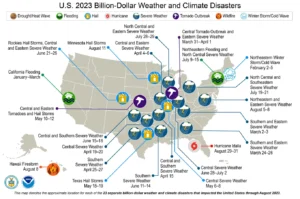As a historically hot summer nears its end, U.S. government scientists on Monday announced that the nation endured 23 separate weather and climate disasters that caused at least $1 billion in damage from January to August—setting a new annual record with four months of the year left.
The previous record was set in 2020, with a year-end total of 22. This year’s billion-dollar disasters so far include 18 severe storms, two flooding events, one tropical cyclone, one wildfire, and one winter storm. The final figure for 2023 could rise, not only because it’s just September, but also because some calculations still need to be finalized, including for Tropical Storm Hilary and a Southern and Midwest drought.
The National Oceanic and Atmospheric Administration (NOAA) said that this year’s events collectively “caused 253 direct and indirect fatalities and produced more than $57.6 billion in damages.” Since the federal agency began tracking billion-dollar disasters in 1980, there have been 371 such events, with the total cost topping $2.615 trillion.
Additions to this year’s total since NOAA’s previous update a month ago include the deadliest U.S. wildfire in over a century, which devastated the Hawaiian island of Maui in early August, and Hurricane Idalia, which made landfall in Florida late last month.

“They affirm what millions of people around the country already know—the climate crisis is a deadly and expensive reality today,” Cleetus continued. “Our choices about where and how we build and develop are also putting more people and property in harm’s way. Without sharp cuts to heat-trapping emissions and robust investments in climate resilience, the human and economic toll of these kinds of disasters will mount in years to come. The year is far from over, with the busiest part of the hurricane season just getting underway, making it likely that these numbers will climb further.”
Along with the disaster figure, NOAA announced that the United States saw its ninth-warmest August in the 129-year record. For a few states—Florida, Louisiana, and Mississippi—it was the hottest August recorded. It was also Texas’ second-hottest and Alaska’s third-hottest August.
This year also featured the nation’s 15th-hottest meteorological summer—or June through August—on record, with Louisiana enduring its warmest summer and Florida and Texas seeing their second-warmest summers. Florida, Louisiana, and Mississippi also all endured their hottest January-August period, while it was the second-warmest in Alabama, Delaware, Georgia, Maryland, and Massachusetts.
NOAA’s findings follow revelations last week that at the global level, this summer has been the hottest ever recorded and in 2022, greenhouse gas concentrations, sea level, and ocean heat content hit record highs.
As Cleetus noted, they also follow a Federal Emergency Management Agency (FEMA) request for “Congress to urgently allocate additional money for disaster aid as it’s slated to run out of funds this month.”
“This kind of a dire situation is likely to happen year after year as climate change worsens,” she warned. “It’s imperative that U.S. policymakers invest much more in getting out ahead of disasters before they strike rather than forcing communities to just pick up the pieces after the fact. While recent legislation like the Inflation Reduction Act and the Infrastructure Investment and Jobs Act include some funding for climate resilience, it’s grossly insufficient given the scale of the national challenge we face.”
“Congress and the Biden administration also must ensure funds are reaching the communities disproportionately affected by climate harms, including low-income communities and communities of color,” she added. “The science is clear that adapting to runaway climate change is an impossible feat so we must also sharply curtail the use of fossil fuels that are driving the climate crisis.”
The NOAA report and response come ahead of the United Nations Climate Action Summit in New York City beginning September 20 as well as COP28, the next U.N. conference for parties to the Paris agreement, which is set to be hosted by the United Arab Emirates this November.
Recent disasters and extreme heat leading up to both summits have fueled demands for more ambitious efforts from the international community—but particularly rich countries that have largely created the climate emergency—to ditch oil and gas. With eyes on the NYC meeting, activists are planning a September 17 March to End Fossil Fuels in the city and hundreds of related events across the United States.
The NYC march’s demands for U.S. President Joe Biden are to stop federal approvals for new fossil fuel projects and repeal permits for “climate bombs”; phase out oil and gas drilling on public lands and waters; declare a climate emergency; and provide a just transition.
 Poli Alert Political & Civics
Poli Alert Political & Civics



